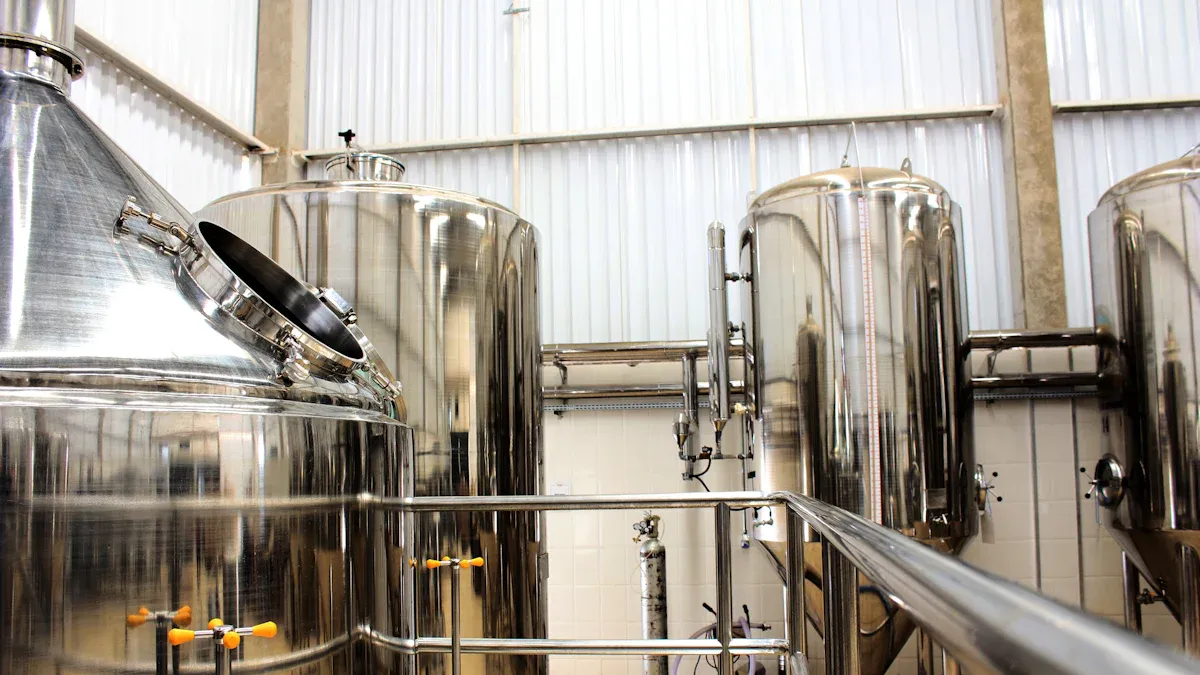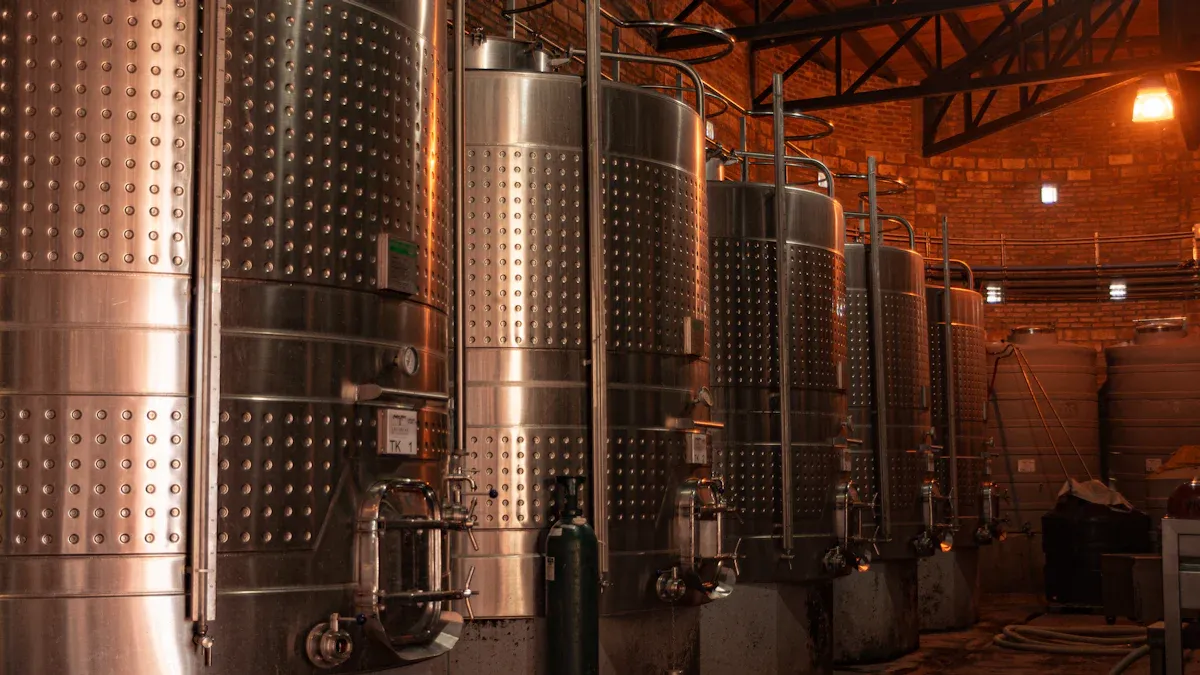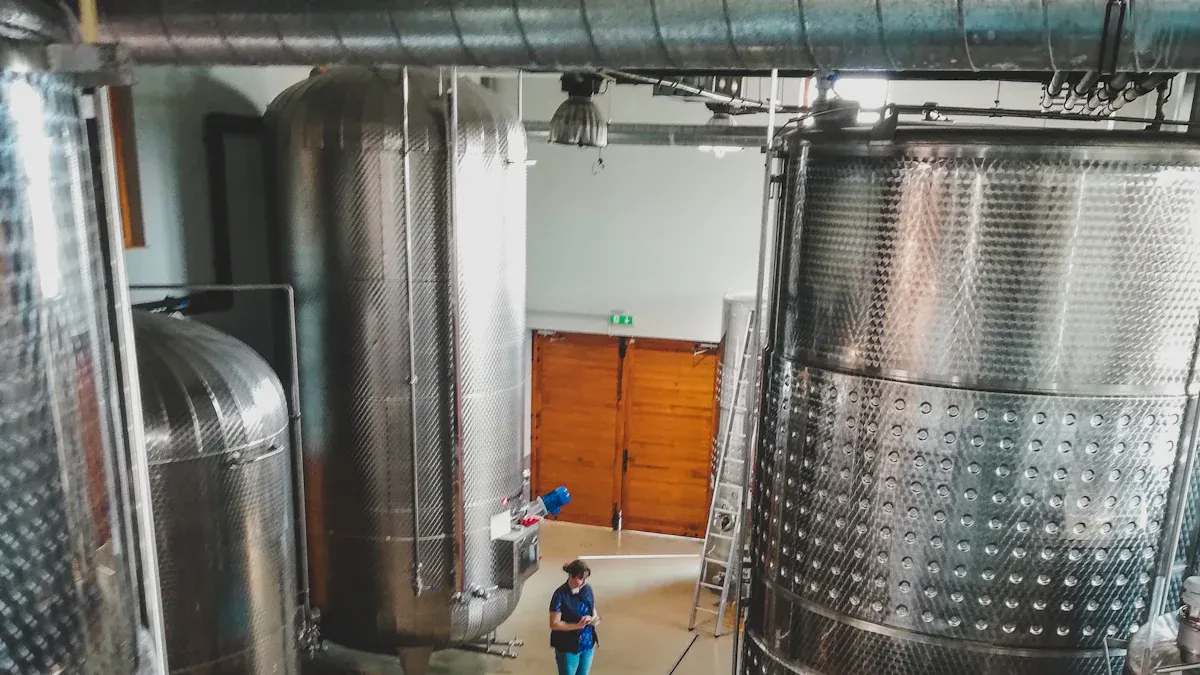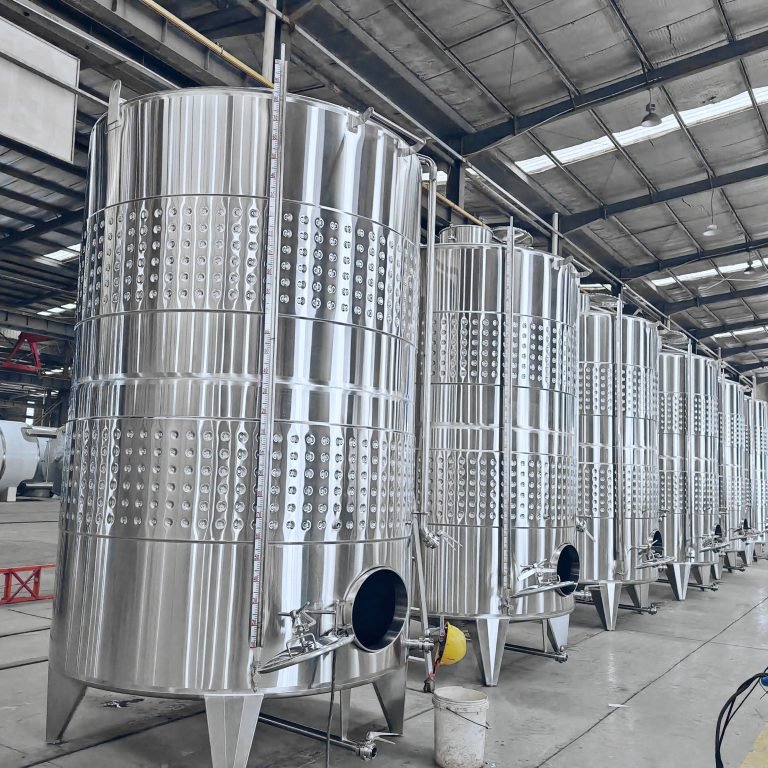
When it comes to modern winemaking, stainless wine tanks are a game changer. Their unmatched durability and innovative features make them a favorite for winemakers like you. Why? These stainless wine tanks stand the test of time, resisting corrosion, scratches, and even the acidic nature of wine. Plus, they’re easy to clean, which means you’ll spend less on water and cleaning chemicals. Over time, this durability and ease of maintenance save money and hassle. Unlike other materials, stainless wine tanks don’t degrade or contaminate your wine, preserving its authentic flavor. With these benefits of stainless wine tanks, you can focus on crafting exceptional wine every step of the way.
Chenma is one of the professional stainless steel wine tank manufacturers that can provide wineries with a variety of solutions. We also provide chemical mixing tank、stainless steel oil tank, ect.
Durability of Stainless Steel Wine Tanks

Corrosion Resistance for Long-Term Use
When it comes to durability, stainless steel wine tanks truly shine. These tanks are built to last, thanks to their exceptional resistance to corrosion. Stainless steel is non-reactive, which means it won’t interact with the acidic nature of wine. This ensures your wine’s flavor stays pure and unaltered. The high chromium and nickel content in stainless steel enhances its ability to resist corrosion, even in humid or acidic environments. This makes stainless steel wine tanks a reliable choice for long-term use.
You’ll also appreciate how these tanks maintain their structural integrity over time. Unlike other materials that may degrade or rust, stainless steel holds up beautifully. This durability not only extends the life of the tanks but also reduces the need for frequent replacements or costly repairs. In the long run, this means more savings for you and less hassle in your winemaking process.
Withstanding Wear and Tear in Winemaking
Winemaking can be tough on equipment, but stainless steel tanks are up to the challenge. They’re designed to handle the daily demands of fermentation, storage, and cleaning without showing signs of wear and tear. The robust construction of these tanks ensures they can withstand physical impacts, scratches, and the rigorous processes involved in winemaking.
Whether you’re fermenting wine or blending it, these tanks provide a sturdy and reliable solution. Their long life means you can count on them for years, even with heavy use. Plus, their smooth, non-porous surface resists damage and makes cleaning a breeze. This combination of strength and practicality makes stainless steel tanks an indispensable tool for any winemaker.
Ease of Cleaning and Maintenance
Non-Porous Surface for Hygiene
Keeping your wine tanks clean is essential for producing high-quality wine. Stainless steel tanks make this task much easier because of their non-porous surface. Unlike other materials, stainless steel doesn’t absorb liquids or harbor bacteria. This means you can maintain a high level of hygiene without much effort. The smooth surface prevents wine residues from sticking, making the tanks easy to clean after each use.
You’ll also appreciate how this non-porous design reduces the risk of contamination. When you’re working with wine, even a small amount of leftover residue can affect the flavor. Stainless steel eliminates this worry, giving you peace of mind that your wine will taste exactly as intended. Plus, the durability of the material ensures that the surface remains intact, even after years of cleaning.
CIP (Clean-in-Place) Technology for Efficiency
If you’re looking for a way to save time and effort, Clean-in-Place (CIP) technology is a game-changer. This system allows you to clean your tanks without disassembling them. It’s not only convenient but also ensures thorough cleaning every time. CIP technology uses a combination of temperature, pressure, and flow to remove residues and sanitize the tanks effectively.
Here’s a quick look at how CIP technology works, based on key performance metrics:
| Metric Type | Description |
|---|---|
| Temperature | Monitored using thermocouples and RTDs; critical for effective cleaning, especially above 75°C. |
| Pressure | Measured with pressure transmitters to assess cleaning efficiency and solution delivery speed. |
| Flow | Flow meters ensure turbulent flow for effective cleaning; electromagnetic flowmeters are preferred. |
| Conductivity | Conductivity meters verify cleaning effectiveness by measuring ionic solution presence. |
| Final Rinse Testing | Includes ATP, APC, or allergen testing to ensure cleanliness post-CIP. |
This technology not only saves you time but also reduces water and chemical usage, making it an eco-friendly choice. With CIP, you can focus more on winemaking and less on cleaning, knowing your tanks are spotless and ready for the next batch.
Flavor Neutrality in Stainless Wine Tanks
Preserving the Authentic Taste of Wine
When you’re crafting wine, preserving its authentic taste is everything. Stainless wine tanks excel at this by offering a neutral flavor profile. Unlike oak barrels that add woody or smoky notes, stainless steel wine tanks let the natural characteristics of the grapes shine through. This means your wine’s true essence stays intact, allowing you to highlight the unique qualities of each batch.
Here’s why stainless steel stands out:
- It doesn’t absorb odors or flavors, so your wine remains pure.
- The material ensures the wine’s natural aroma and taste aren’t altered by the container.
- Stainless steel emphasizes the grapes’ original profile, making it ideal for winemakers who value authenticity.
With stainless steel tanks, you can focus on creating wine that reflects your vision without worrying about unwanted flavors sneaking in.
Avoiding Contamination from Tank Materials
Contamination can ruin a batch of wine, but stainless steel tanks help you avoid this risk. Their surfaces are easy to clean, which minimizes the chance of residue buildup or bacterial growth. Plus, stainless steel is highly resistant to corrosion, ensuring that your wine stays safe during fermentation and storage.
Here’s how stainless steel protects your wine:
- It’s neutral and doesn’t impart any flavors, keeping your product pure.
- The material’s durability prevents chemical reactions that could contaminate the wine.
- Some tanks even include inert gas systems to shield the wine from external contaminants during storage.
By choosing stainless steel wine tanks, you’re investing in a reliable solution that safeguards your wine’s quality. You’ll have peace of mind knowing your tanks won’t compromise the purity of your product.
Temperature Control Features

Built-In Cooling and Heating Systems
Temperature control is one of the standout features of stainless steel wine tanks. These tanks come equipped with built-in cooling and heating systems, making them an ideal choice for maintaining precise conditions during wine fermentation. Whether you’re dealing with hot summers or chilly winters, these systems adapt to your needs effortlessly.
Here’s what makes these systems so effective:
- Integrated cooling jackets wrap around the tank body, providing ideal chilling capabilities for fermentation.
- Heating devices ensure consistent temperatures in colder environments, keeping your wine fermentation process on track.
- Available in capacities ranging from 100 liters to 500,000 liters, these tanks cater to wineries of all sizes.
- Constructed from high-quality stainless steel (SUS304 or SUS316L), they feature heavy-duty plates with thicknesses between 2mm and 5mm.
You’ll love how customizable these tanks are. Whether you need specific temperature ranges or unique processing requirements, they can be tailored to fit your winemaking goals. With these advanced systems, you can focus on crafting exceptional wine without worrying about fluctuating temperatures.
Precision for Fermentation and Aging
Precision is key when it comes to fermentation and aging, and stainless steel tanks deliver it flawlessly. These tanks are equipped with cooling jackets and heating devices that allow you to control temperatures with pinpoint accuracy. During fermentation, cooling jackets help maintain low temperatures, which are essential for preserving the wine’s delicate flavors.
For aging, the heating devices step in to regulate conditions, ensuring your wine develops its full character. This level of control lets you fine-tune every batch, creating wines that reflect your vision perfectly.
Here’s why these tanks excel in precision:
- Cooling jackets distribute cold evenly across the tank, preventing temperature spikes that could disrupt fermentation.
- Heating systems provide stable warmth, especially in colder climates, ensuring optimal conditions for aging.
With these advanced systems, you can achieve consistent results every time. Whether you’re fermenting or aging, stainless steel tanks give you the tools to create wine that stands out.
Cost-Effectiveness of Stainless Steel Wine Tanks
Long-Term Savings on Maintenance
When you invest in stainless steel tanks, you’re setting yourself up for long-term savings. These tanks are built to last, with a lifespan of 30 to 50 years. Compare that to oak barrels, which need replacing every 3 to 5 years, and the difference is clear. Stainless steel tanks rarely require replacements, saving you both time and money.
Here’s a quick comparison to show how much you can save:
| Cost Factor | Stainless Steel Tanks | Oak Barrels |
|---|---|---|
| Lifespan | 30–50 years | 3–5 years |
| Replacement Frequency | Rare | Frequent |
| Maintenance Costs | Low | Moderate to High |
These tanks are also easy to clean, which reduces maintenance costs even further. Their smooth, non-porous surface prevents residue buildup, so you’ll spend less on cleaning chemicals and water. Over time, these savings add up, making stainless steel tanks a smart choice for your winery.
High Return on Investment for Winemakers
Stainless steel tanks don’t just save you money—they help you make better wine. Their advanced features, like precise temperature control and resistance to oxidation, ensure consistent quality in every batch. This means fewer risks during fermentation and storage, which translates to fewer losses.
Here’s why these tanks deliver a high return on investment:
- They give you better control over fermentation, reducing issues like temperature fluctuations.
- Their durability means you won’t need to replace them for decades.
- They’re designed for efficiency, helping you produce high-quality wine with fewer complications.
With a lifespan of over 20 years, stainless steel tanks pay for themselves many times over. You’ll not only save on maintenance but also enjoy the benefits of producing exceptional wine that keeps your customers coming back.
Versatility in Winemaking Applications
Suitable for Fermentation, Storage, and Blending
Stainless steel fermentation tanks are incredibly versatile, making them a perfect fit for every stage of winemaking. Whether you’re fermenting, storing, or blending wine, these tanks adapt to your needs effortlessly. Their design supports a wide range of applications, ensuring you can experiment and refine your craft without limitations.
Take fermentation, for example. Stainless steel tanks come in various types to suit different styles of wine production. Open-top fermentation tanks are ideal for red wines, helping you extract rich colors and bold flavors. Closed-top tanks work best for white wines, offering protection against contamination while maintaining precise temperature control. Variable capacity tanks let you adjust to different batch sizes, minimizing oxygen exposure and giving you the freedom to try new fermentation techniques.
Here’s a quick look at how these tanks excel in different applications:
| Tank Type | Application Description |
|---|---|
| Open-Top Fermentation | Perfect for red wine production, enhancing color and flavor extraction. |
| Closed-Top Fermentation | Ideal for white wines, providing maximum protection against contamination and compatibility with temperature control systems. |
| Variable Capacity Tanks | Adapt to different batch sizes, minimizing oxygen exposure and allowing for experimentation with various fermentation styles. |
| Jacketed Tanks | Offer precise temperature regulation, crucial for maintaining yeast activity during fermentation. |
| Specialized Tanks | Cater to unique fermentation needs of red and white wines, ensuring optimal results. |
When it comes to storage, stainless steel tanks shine again. Their non-porous surface keeps your wine safe from contamination, while their durability ensures long-term reliability. For blending, these tanks provide a neutral environment, allowing you to mix different batches without altering the wine’s natural profile.
Adaptable to Various Wine Styles
No matter what type of wine you’re crafting, stainless steel tanks adapt beautifully. They’re a favorite among winemakers who value flexibility and precision. Whether you’re producing crisp white wines, bold reds, or sparkling varieties, these tanks help you achieve the perfect result.
For instance, a boutique winery in California switched from oak barrels to stainless steel tanks for white wine fermentation. The result? Improved crispness and freshness, thanks to better temperature control. In France, a winery used stainless steel tanks for sparkling wine production. Their durability and ability to withstand pressure during secondary fermentation made them an excellent choice.
Here’s why these tanks work for different wine styles:
- They maintain consistent temperatures, essential for preserving delicate flavors in white wines.
- Their pressure resistance supports the unique demands of sparkling wine production.
- Their neutral surface ensures the natural characteristics of red wines remain intact.
Whether you’re experimenting with new styles or perfecting traditional ones, stainless steel tanks give you the tools to succeed. Their adaptability makes them a must-have for home winemaking and professional wineries alike.
Environmental Benefits of Stainless Steel Wine Tanks
Recyclable Material for Sustainability
If you care about sustainability, stainless steel wine tanks are a fantastic choice. These tanks are nearly 100% recyclable, which means they can be reused without losing their quality. Unlike other materials, stainless steel doesn’t degrade during the recycling process. This makes it a smart option for reducing waste and conserving natural resources.
Here’s why stainless steel stands out in terms of recyclability:
- It retains 100% of its strength and durability, even after being recycled.
- Steel is the most recycled material globally, making it an environmentally friendly option.
- The long lifespan of stainless steel tanks means fewer replacements, which contributes to sustainability.
By choosing stainless steel tanks, you’re not just investing in reliable equipment—you’re also helping the planet. These features make stainless steel a win-win for both your winery and the environment.
Energy Efficiency in Production and Use
Energy efficiency is another big win for stainless steel tanks. Wineries often consume a lot of electricity for cooling and fermentation processes, but stainless steel tanks help minimize this impact. Their efficient temperature regulation systems reduce energy waste, making them a greener choice for winemaking.
Take a look at how stainless steel tanks contribute to energy savings:
| Aspect | Statistic/Impact |
|---|---|
| Energy consumption for cooling | Wineries consume up to 90% of their electricity for cooling processes, including fermentation control. |
| Fermentation energy consumption | Fermentation accounts for 45% to 90% of a vineyard’s entire energy consumption, depending on size and efficiency. |
| Temperature management | Efficient temperature regulation minimizes waste and lowers environmental impact. |
These tanks are designed to optimize energy use during fermentation and storage. Their advanced cooling and heating systems ensure precise temperature control, which not only improves wine quality but also reduces your carbon footprint.
By using stainless steel tanks, you’re taking a step toward a more sustainable winemaking process. You’ll save energy, lower costs, and contribute to a healthier planet—all while crafting exceptional wine.
Aesthetic and Practical Design
Modern Appearance for Wineries
Stainless steel tanks don’t just perform well—they look great too. Their sleek, polished finish adds a modern touch to any winery. When visitors walk into your cellar, these tanks create a professional and clean atmosphere. They reflect light beautifully, making your space feel brighter and more inviting.
Unlike traditional wooden barrels, stainless steel tanks give your winery a contemporary vibe. This modern aesthetic appeals to customers who value innovation and quality. Plus, their uniform design makes your cellar look organized and efficient. Whether you’re running a boutique winery or a large-scale operation, these tanks enhance the overall appearance of your space.
Space-Saving Features like Stacking Technology
If you’re short on space, stainless steel tanks with stacking technology are a game-changer. These tanks are designed to maximize your cellar’s efficiency by utilizing vertical space. For example, two 300-gallon Vino ProTanks can replace ten 55-gallon barrels. That’s a huge improvement in space usage!
Here’s how stacking technology works:
- The tanks come with an integrated, pallet-style platform, making them easy to stack.
- You can stack them three high, even when they’re full, which means you can store more wine in less space.
- This design not only saves room but also improves accessibility, so you can manage your inventory more easily.
By switching to tanks with stacking features, you’ll free up valuable floor space. This allows you to focus on expanding production or creating a more comfortable workspace. It’s a practical solution that combines functionality with smart design.
Why Consider Purchasing Stainless Steel Wine Tanks from Chenma
Expertise in Custom Tank Manufacturing
When it comes to crafting stainless steel wine tanks, Chenma stands out. You’re not just buying a tank; you’re investing in a solution tailored to your needs. Chenma’s team of over 200 professionals works in a state-of-the-art facility spanning 20,000 square meters. They don’t just manufacture tanks—they engineer them to fit your unique winemaking process.
Imagine having tanks designed specifically for your winery’s fermentation, storage, or blending needs. Chenma’s talented engineers make this possible. They modify catalog products or create completely custom tanks based on your requirements. Whether you need a tank with precise temperature control or one that maximizes space efficiency, Chenma delivers.
Their expertise doesn’t stop at manufacturing. Chenma offers turnkey solutions, including process design, installation, and technical training. This means you’ll have everything you need to streamline your winemaking process. With Chenma, you’re not just purchasing stainless steel wine tanks; you’re gaining a partner in innovation.
Certified Quality and Safety Standards
Quality and safety matter when you’re crafting wine, and Chenma takes these seriously. Every tank is manufactured to meet the latest industry standards. Chenma has earned certifications like ISO9001-2005 for quality management and ISO14001-2015 for environmental practices. These certifications ensure that the tanks you receive are reliable, durable, and eco-friendly.
Safety is another priority. Chenma’s tanks comply with OHSAS18001-2007 occupational health standards and EU CE certification. This means you can trust their tanks to perform safely under demanding conditions. Whether you’re fermenting wine or storing it long-term, these tanks provide peace of mind.
Chenma’s commitment to quality doesn’t end with certifications. Their tanks are built using high-grade stainless steel, ensuring corrosion resistance and long-term durability. You’ll appreciate how these tanks maintain their integrity, even after years of use. With Chenma, you’re choosing tanks that combine precision, safety, and sustainability.
Stainless steel wine tanks offer a winning combination of durability, cost-effectiveness, and environmental benefits. Their long lifespan means fewer replacements, saving you time and money. Plus, their larger volume compared to wooden barrels optimizes space and reduces costs. These tanks also ensure cleaner wine by avoiding flavor impartation.
Here’s a quick look at their overall benefits:
| Benefit | Description |
|---|---|
| Durability | Long lifespan reduces the need for frequent replacements of barrels. |
| Cost-effectiveness | Larger volume than wooden barrels saves money on space and replacements. |
| Environmental impact | No flavor impartation on wine, unlike wooden barrels, leading to cleaner wine. |
If you’re looking for reliable, high-quality solutions, stainless steel wine tanks from trusted manufacturers like Chenma are a smart choice. They’ll help you craft exceptional wine while supporting sustainability.
FAQ
What makes stainless steel wine tanks better than oak barrels?
Stainless steel tanks last longer, are easier to clean, and don’t alter the wine’s flavor. Oak barrels need frequent replacement and add woody notes to the wine. If you want to preserve the authentic taste of your grapes, stainless steel is the way to go.
Can stainless steel tanks handle both fermentation and storage?
Absolutely! Stainless steel tanks are versatile. You can use them for fermentation, storage, and even blending. Their temperature control systems make them perfect for every stage of winemaking. Whether you’re crafting reds, whites, or sparkling wines, these tanks adapt to your needs.
Are stainless steel wine tanks eco-friendly?
Yes, they are! Stainless steel is nearly 100% recyclable, making it a sustainable choice. Plus, their energy-efficient temperature control systems reduce electricity usage during fermentation and storage. By choosing stainless steel, you’re helping the planet while producing exceptional wine. 🌍🍷
How long do stainless steel wine tanks last?
Stainless steel tanks can last 30 to 50 years with proper care. Their corrosion resistance and durable construction mean fewer replacements compared to oak barrels. This longevity saves you money and ensures consistent performance for decades.
Can I customize stainless steel wine tanks for my winery?
Yes, you can! Manufacturers like Chenma offer custom designs tailored to your specific needs. Whether you need precise temperature control, unique sizes, or space-saving features, they’ll create tanks that fit your winemaking process perfectly. It’s like having equipment built just for you!



